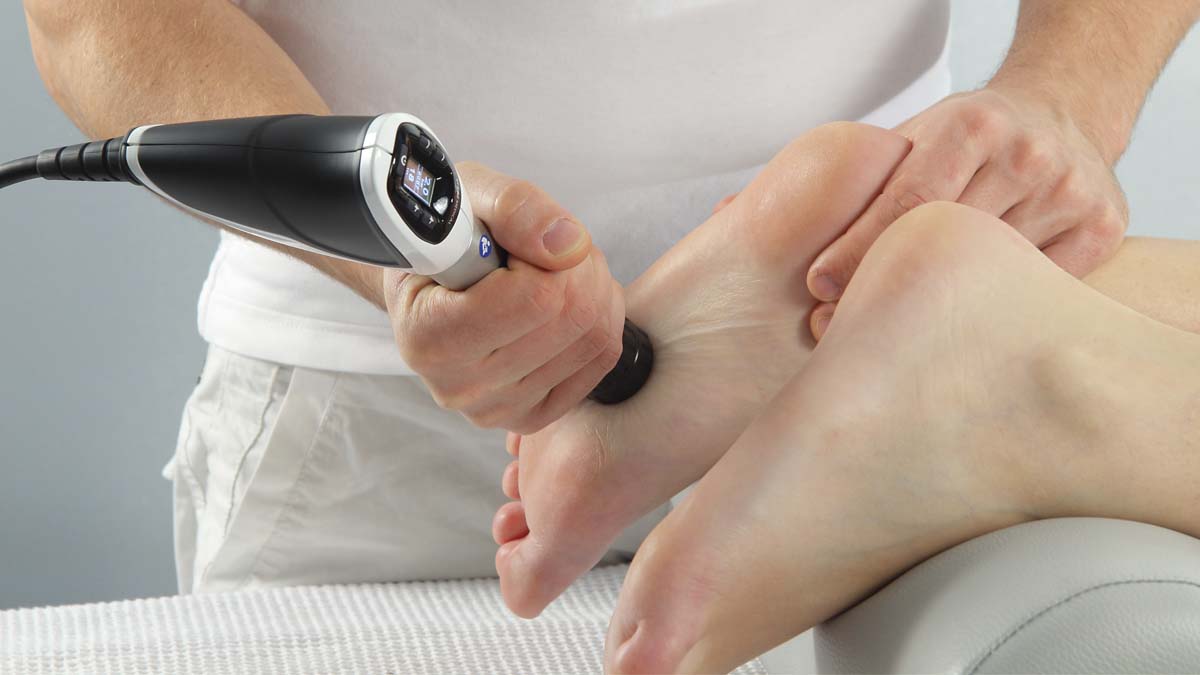For people experiencing chronic pain in their extremities, shockwave therapy offers a safe and innovative option that includes the benefits of short treatment time, quick recovery and no side effects.
Also called extracorporeal pulse activation technology, shockwave therapy, which is approved by the Food and Drug Administration, is a noninvasive technology that helps alleviate acute or chronic musculoskeletal pain. It offers an alternative to surgery, an injection or medicine with no anesthesia, no downtime and no scarring. The treatment delivers acoustic pressure waves applied through a wand directly into your areas of pain, converting to heat once it reaches your deeper layers of tissue to repair damage, relieve pain and restore function.
Stewart Williamson B.S., D.C., of Charleston Chiropractic Center, has been using state-of-the-art shockwave technology for more than seven years. He utilizes the Storz Medical CuraMedix OrthoPulse model, which emits a radial pulse that sounds like a small jackhammer, converting mechanical energy into a small sound wave.
Dr. Williamson uses shockwave therapy to treat rotator cuff and shoulder injuries, plantar fasciitis, low back pain and tennis and golf elbow.
“I’ve had tremendous results,” he said.
Dr. Williamson once received the shockwave therapy treatment himself for turf toe, and it worked so well that he bought the machine for Charleston Chiropractic Center.
He explained that shockwave therapy breaks up scar tissue and prompts the body to re-initiate the healing process through the micro trauma created by the acoustic waves. The tissue continues to regenerate after treatment and create the formation of new blood vessels.
“This is restorative medicine; this is healing,” asserted Dr. Williamson.
Shockwave therapy typically involves performing one or two treatments a week; the healing process can take up to 12 weeks. Dr. Williamson has had people drive to his clinic from as far away as Myrtle Beach to receive shockwave therapy because the procedure isn’t offered in their area.
For optimal results, Dr. Williamson combines shockwave therapy with other therapies, including class IV photobiomodulation laser therapy. He described shockwave therapy as “natural healing at a high level of technology.”
“Generally patients will walk out feeling immediately better because there’s healing in the tissue,” he said. “Patients can experience a reduction in pain during treatment.”
Types of shockwave therapy
Blake Ohlson, M.D., an orthopedic surgeon who joined Charleston Sports Medicine in August, explained that there are two types of shockwave therapy: radial pulse and focus. Both utilize acoustic waves to try to stimulate the tissue and facilitate healing. Charleston Sports Medicine, which also uses the Storz Medical CuraMedix model, has been offering radial pulse shockwave therapy treatment for the past couple years to treat conditions such as Achilles’ disorders, tennis elbow and plantar fasciitis.
He said Charleston Sports Medicine is one of only a few places in the area using focus shockwave, which it has offered since September. In addition to relieving other conditions, it is used to treat bone disorders such as arthritis.
“It has the ability to penetrate with depth,” stated Dr. Ohlson.
Shockwave therapy generally entails three to five treatments, depending on the type of tissue involved. Like Dr. Williamson, he noted that the healing process can take anywhere from six to 12 weeks. Dr. Ohlson can provide a combination of radial pulse and focus treatments as well. The procedure can take around five to seven minutes for one or 10 minutes for both.
While there is some discomfort during the treatment, patients usually feel fine afterward. It is geared toward individuals who are looking for an option other than surgery.
“These are folks who are not ready to go to the operating room,” remarked Ohlson. “There’s no risk of complications.”
As shockwave technology has improved, practices are able to apply the devices to a wider range of conditions, according to Dr. Ohlson.
Ryan Butler received a combination of radial pulse and focus shockwave therapy at Charleston Sports Medicine to treat an elbow injury. He hurt his left elbow lifting weights while on vacation, but, other than taking ibuprofen, he waited to see if it would improve on its own.
After three months, the pain hadn’t subsided, so he saw Dr. Ohlson and received a cortisone shot. It didn’t work and the pain returned. He then tried shockwave therapy, undergoing four sessions over four weeks. Even following the first session he felt some improvement. Butler said the treatment wasn’t invasive, and, although there was slight discomfort, he could feel it working.
“After the fourth treatment, I wasn’t in pain at all,” Butler recalled. “I’m a firm believer in it. It helped.”
By Colin McCandless







